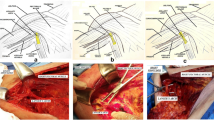Abstract
Purpose
When Carl Langer described the aberrant axillary arch in 1846 its relevance in sentinel node biopsy (SNB) surgery could not have been contemplated. The authors define an incidence and elucidate relevance of the arch in SNB of the axilla.
Methods
A review of a database for breast and melanoma axillary SNB was carried out. The sample was 1 year at Princess Margaret Hospital, Toronto.
Results
Of 319 axillary SNB, 3 (0.9%) had axillary arches noted. Two were in the melanoma group (n = 59) and one in the breast (n = 260). Interestingly one arch case had an ipsilateral ‘idiopathic’ axillary vein thrombosis as a child.
Conclusions
The authors see no reason to deviate from the practice of division of the arch at the highest level when recognised at SNB. This would abrogate the risk of concealed nodes and possible future neurovascular compression.


Similar content being viewed by others
References
Besana-Ciani I, Greenall MJ (2005) Langer’s axillary arch: anatomy, embryological features, surgical implications. Surgeon 3:325–327
Boileau JF, Easson A, Escallon JM et al (2008) Sentinel nodes in breast cancer: relevance of axillary level ii nodes and optimal number of nodes that need to be removed. Ann Surg Oncol 15:1710–1716
Boontje AH (1979) Axillary vein entrapment. Br J Surg 66:331–332
Chene G, Le Bouedec G, Dauplat J (2007) arch and sentinel: surgical technique of sentinel node biopsy with the axillopectoral muscle. Gynecol Obstet Fertil 35:25–29
Dharap A (1994) An unusually medial axillary arch muscle. J Anat 184:639–641
Jelev L, Georgiev GP, Surchev L (2007) Axillary arch in human: common morphology and variety. Definition of “clinical” axillary arch and its classification. Ann Anat 189:473–481
Langer C (1846) Zur anatomie des musculus latissimus dorsi. Osterr Med Wochenschr 15:454–458
McCready DR, Ghazarian DM, Hershkop MS et al (2001) Sentinel lymph-node biopsy after previous wide local excision for melanoma. Can J Surg 44:432–434
Miguel M, Llusa M, Ortiz JC et al (2001) The axillopectoral muscle (of langer): report of three cases. Surg Radiol Anat 23:341–343
Petrasek AJ, Semple JL, McCready DR (1997) The surgical and oncologic significance of the axillary arch during axillary lymphadenectomy. Can J Surg 40:44–47
Serpell JW, Baum M (1991) Significance of ‘langer’s axillary arch’ in axillary dissection. Aust N Z J Surg 61:310–312
Suzuma T, Sakurai T, Yoshimura G et al (2003) Magnetic resonance axillography for preoperative diagnosis of the axillopectoral muscle (langer’s axillary arch): a case report. Breast Cancer 10:281–283
Testut L (1884) Les anomalies musculaires chez l’homme explique ‘es par l’anatomie compare’e et leur importance en anthropologie. Masson, Paris, pp 107–117
Uzmansel D, Kurtoğlu Z, Kara A, Öztürk NC (2010) Frequency, anatomical properties and innervation of axillary arch and its relation to the brachial plexus in human fetuses. Surg Radiol Anat. doi:10.1007/s00276-010-687-4
Conflict of interest
The authors declare that they have no conflict of interest.
Author information
Authors and Affiliations
Corresponding author
Rights and permissions
About this article
Cite this article
Ridgway, P.F., Collins, A.M. & McCready, D.R. The surgical importance of an axillary arch in sentinel node biopsy. Surg Radiol Anat 33, 147–149 (2011). https://doi.org/10.1007/s00276-010-0724-3
Received:
Accepted:
Published:
Issue Date:
DOI: https://doi.org/10.1007/s00276-010-0724-3




